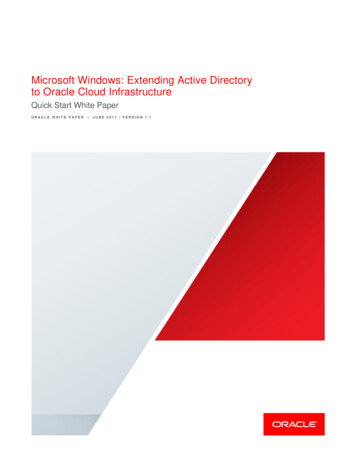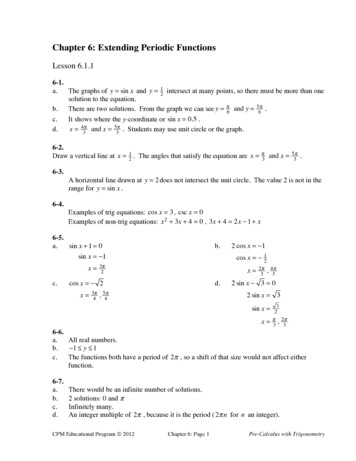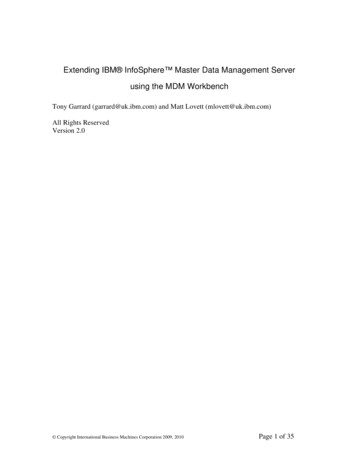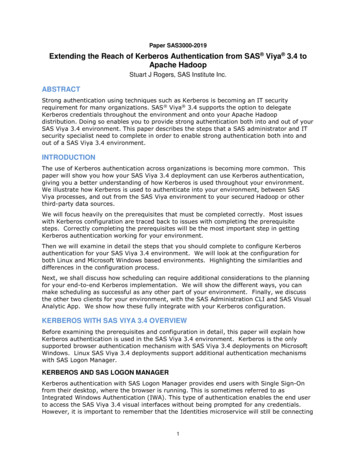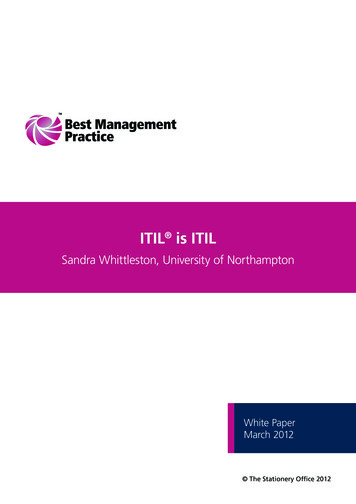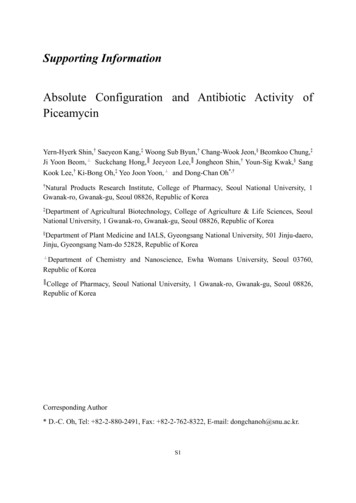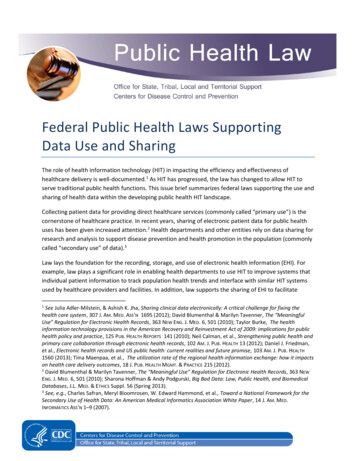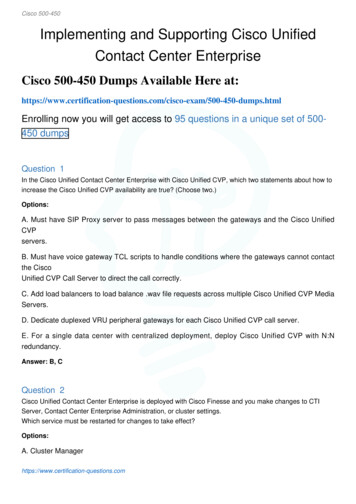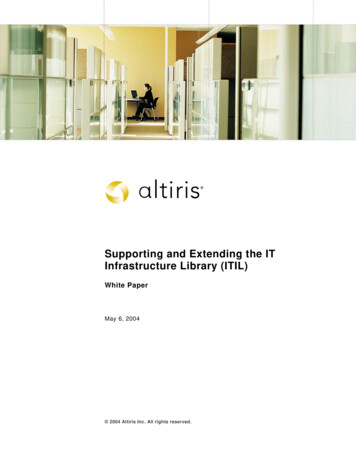
Transcription
Supporting and Extending the ITInfrastructure Library (ITIL)White PaperMay 6, 2004 2004 Altiris Inc. All rights reserved.
ABOUT ALTIRISAltiris, Inc. is a pioneer of IT lifecycle management software that allowsIT organizations to easily manage desktops, notebooks, thin clients,handhelds, industry-standard servers, and heterogeneous softwareincluding Windows, Linux, and UNIX. Altiris automates and simplifies ITprojects throughout the life of an asset to reduce the cost and complexityof management. Altiris client and mobile, server, and asset managementsolutions natively integrate via a common Web-based console andrepository. For more information, visit www.altiris.com.NOTICEThe content in this document represents the current view of Altiris as of the date of publication. Because Altirisresponds continually to changing market conditions, this document should not be interpreted as a commitment onthe part of Altiris. Altiris cannot guarantee the accuracy of any information presented after the date of publication.Copyright 2004, Altiris, Inc. All rights reserved.Altiris, Inc.588 W est 400 SouthLindon, UT 84042Phone: (801) 226-8500Fax: (801) 226-8506BootW orks U.S. Patent No. 5,764,593.RapiDeploy U.S. Patent No. 6,144,992.Altiris, BootW orks, Inventory Solution, PC Transplant, RapiDeploy, and RapidInstall are registered trademarks ofAltiris, Inc. in the United States.Carbon Copy is a registered trademark licensed to Altiris, Inc. in the United States and a registered trademark ofAltiris, Inc. in other countries.Microsoft, W indows, and the W indows logo are trademarks, or registered trademarks of Microsoft Corporation inthe United States and/or other countries.Other brands and names are the property of their respective owners.Information in this document is subject to change without notice. For the latest documentation, visitwww.altiris.com.www.altiris.com
CONTENTSIntroduction. 1What is ITIL? . 2ITIL Processes . 3Service Desk (ITIL Function)Service Desk GoalsITIL Service Support334Configuration Management4Incident Management5Problem Management6Change Management7Release Management8ITIL Service Delivery9Service Level Management10Availability Management11Capacity Management12Financial Management for IT Services13IT Service Continuity Management14Sarbanes-Oxley and ITIL . 15Conclusion . 16More Information . 17Appendix . 18Altiris Solutions Mapping to ITIL ProcessesDefinition of Tool Categorieswww.altiris.com1818
www.altiris.com
INTRODUCTIONReduced budgetsand growingdemands on IT haveforced organizationsto find ways to cutcosts, increase ITresource productivity,and optimize existinginvestments.www.altiris.comIT organizations are constantly being asked to do more with less.Reduced budgets and growing demands on IT have forced organizationsto find ways to cut costs, increase IT resource productivity, and optimizeexisting investments. Organizations have several opportunities to reducecosts. An attractive option is through standardization of processes.Companies are constantly developing and redeveloping processes tostreamline organizational efficiency. This proves to be costly andunproductive. As a result, IT organizations have turned to the InformationTechnology Infrastructure Library (ITIL) to provide guidance to theirdevelopment and implementation of standardized processes. Why recreate the wheel?As a result of ITIL focus on process, the following document is designedto supply an overview of ITIL, as well as provide extensions to theframework to incorporate the use of applications to support ITILimplementation.Supporting and Extending the ITIL Library 1
WHAT IS ITIL?ITIL was conceived in response to increased dependency on IT and theneed for process standardization. ITIL is a set of detailed processguidelines, presented in a series of books, containing recommendedglobal best practices, workflow, templates, and terminology, developedby the United Kingdom’s Office of Government Commerce (OGC). TheITIL books are the only comprehensive, publicly available guidance for ITmanagement.ITIL has become a worldwide de facto standard for IT managementprocess implementation and continues to mature and extend its depthand breadth of guidance. In addition to assisting organizations tostandardize on process, ITIL also provides definitions of commonlanguage to promote a forum of communication and ensure companiesuse the same terminology.2 Supporting and Extending the ITIL Librarywww.altiris.com
ITIL PROCESSESThere are 10 core modules that comprise the ITIL framework. They aregrouped in two sets of five under Service Support and Service Delivery.Although ITIL is focused on service management, asset managementand configuration management provide the foundation to all ITILprocesses. It is important to note that all processes depend oncontinuous interaction with each other.Service Desk (ITIL Function)Unlike Service Support and Service Delivery, which are consideredprocesses, the service desk is a function. The Service Desk is designedto be the main contact point between the end user and the ITorganization—the service supplier. The service desk is crucial to thewhole concept of Service Management and is probably the mostimportant function within the organization. For many end users, theservice desk is their only source of interaction with the IT departmentand is the single view of professionalism offered by the entire ITorganization.For many companies the service desk provides a cohesive front to asiloed IT organization and infrastructure. A siloed approach to servicemanagement creates multiple difficulties, including redundant andinefficient use of skilled resources, loss of communication, lengthyresolution times, excessive costs, decreased end-user satisfaction andmay adversely affect corporate competitive advantage. The goal of theservice desk is to develop a consolidated, team atmosphere to helpadopt proactive and structured working practices. It also provides acentral contact point for all end-user requests, including basic questions,incidents, problems, and change requests (change requests includeprocurement requests).The service desk is comprised of capturing large volumes of calls(employee self-help requests) and caller information, management ofIncidents, support maintenance contracts and software licenses,management of asset configuration and relationships, and service levelagreement (SLA) fulfillment and entitlement management.Service Desk Goals Provide a unified contact point for end-user communication Align people, process and technology to support the business Increase end-user satisfactionTo support consolidation of service resources into a service deskfunction, it is advised to carefully outline the types of services theorganization will support and what resources fulfill specific servicerequirements. Service Management tools should be pre-integrated andprovide easy access to user’s asset configuration data and associatedwww.altiris.comSupporting and Extending the ITIL Library 3
assets, locations, contracts, SLAs, and resolution tools including historicasset support activities, knowledge management, remote control, siteand server monitoring tools, backup and restoration facilities, andapplication metering. A pre-integrated, single console should providetechnicians with rule-based driven tools for analysis, resolution, andexecution to ensure service agreement fulfillment and end-usersatisfaction, while eliminating support costs associate with managingintegration points between disparate support tools.ITIL Service SupportService Support is comprised of five distinct, yet interdependentprocesses focused on ensuring infrastructure availability and accuracythrough execution and tracking of activities.Configuration ManagementConfiguration Management is the process of identifying and definingconfiguration items (CIs) within a logical model of the infrastructure andverifying the completeness and correctness of the ConfigurationManagement Database (CMDB). In addition to identifying CIs,Configuration Management also supports the process of creating logicalrelationships of assets, including location, configuration, peer-to-peer,parent-child, cost centers, departments, and user associations.Configuration Management Goals Manage all CIs and configurations within the organization and itsservices Provide accurate information on CI configurations to supportproactive management of asset availability and help buildservices designed to support corporate initiatives Provide a CMDB foundation for Incident Management, ProblemManagement, Change Management, and Release Managementactivities Ensure CMDB correctness through continuous verificationCurrent, reliable, and accurate asset data is the foundation of all serviceactivities. An accurate CMDB allows service organizations to betterdiagnose and resolve incidents, proactively manage infrastructureproblems, and reduce risk of change activities by understanding CIinterdependencies. In addition to supporting service activities, the CMDBprovides visibility into how assets are utilized and who is using them.Without a firm understanding of asset information, it is near impossible toexecute accurate purchasing and reallocation decisions. You need toknow what you have before you can make strategic decisions.4 Supporting and Extending the ITIL Librarywww.altiris.com
There are many opportunities for organizations to gain asset visibility.The most effective way is through the implementation of process andautomation. Automation can provide a quick way to discover IT assetsand complete CMDB population for discoverable CIs. Native integrationbetween inventory tools and the CMDB is imperative to reduce costsassociated with managing integration points and ensure CMDBinformation is accurate. Although many application vendors containinventory and CMDB functionality, they are built on separatearchitectures and repositories causing IT to focus costly resources onmanaging integration points and multiple databases. Leveraging a singlearchitecture for Inventory and CMDB components creates a trustedsource of data and eliminates support overhead. Physical audits canhelp to ensure data accuracy and management of non-discoverable andconsumable assets. Non-discoverable assets should also be managedwithin the CMDB to ensure complete management of all IT infrastructureresources.Incident ManagementIncident management aims to restore normal service operation as quicklyas possible to minimize the adverse impact on business operations. Thisensures the highest level of asset availability and reliability to end users.And as a result allows users to continue to work in their known workingenvironment.Incident Management Goals Successfully manage incident (end user or infrastructure issue)lifecycle through analysis, diagnosis, and resolution Accurately align resources to carry out completion and resolutionof incidents Ensure restoration of service to known working state withinagreed upon service levelsIncident management is typically known as the management of break/fixactivities; however, ITIL includes requests for new or additional servicesas objects supported by incident management. Given the nature ofincidents, they are typically managed through reactionary procedures.Reactionary procedures must be managed through an effectiveescalation and assignment process to ensure the right IT resources areworking toward resolution. Incident tracking tools can greatly increasethe speed of resolution through automated capturing and presentation ofend user information (user name, location, assets, asset configuration,and historical procedures). Incident management interacts withconfiguration management to supply technicians with detailed assetinformation to ensure full understanding of the user’s asset environmentand performance.www.altiris.comSupporting and Extending the ITIL Library 5
Tools that support the incident management process should be designedto quickly provide technicians with the information they need to analyze,diagnose, and resolve incidents within a single console. The idealconsole should provide rule-based integration to analysis and executiontools to automatically recommend tools for technicians to quickly resolvecustomer issues without leaving the incident record. Incidentmanagement tools are typically aligned with knowledge managementcapabilities to empower technicians to quickly search for commonincidents and knowledge documents to quickly apply fixes within allottedtimes specified by predetermined SLAs.Implementation of self-help solutions can greatly reduce direct customerinteraction with the service desk while providing technical resources forend users to search knowledge base articles, open, update, view status,and close Incident records. Self-help solutions have proved to be aneffective means reducing incident support costs and increasing customersatisfaction levels by empowering end users to support themselves.In many instances, the fix may result in a need to interact with the enduser via automated tools or through field service activities. Most serviceorganizations attempt to limit field service activities to decrease servicecosts, as well as ensure that technicians can continue to resolve otherreceived incidents. With this in mind, automated tools becomeincreasingly more important to execute incident resolution. Theseexecution tools include remote control, client recovery through backupand restoration of PC personality, and software delivery. A standardincident management tool should support a pre-integrated approach toallowing technicians to access execution tools to resolve incidentswithout leaving the record and automatically capture performed activitieswithin the incident history log.Problem ManagementThe problem management process is designed to help organizationsdetermine the underlying root cause of incidents and to proactivelyidentify infrastructure errors before they affect end users. Problemmanagement should benefit end users by ensuring asset availability,while increasing the efficiency of the service organization by proactivelyremoving probable incidents (reduction of redundant calls to the servicedesk).The problem management process has both reactive and proactiveaspects. The reactive aspect is concerned with solving problems inresponse to one or more incidents. Proactive problem management isconcerned with identifying and solving problems and known errors beforeincidents occur in the first place.6 Supporting and Extending the ITIL Librarywww.altiris.com
Problem Management Goals Determine root cause of Incidents to ensure asset availability andhelp reduce the number of contacts to the service desk Proactively analyze trends to identify infrastructure errors beforethey affect end user productivity Ensure the optimization of asset effectiveness through proactivemanagementThe problem management process is supported through detailedanalysis of infrastructure trends. IT organizations have many optionswhen attempting to understand the cause of incidents. One option is tostudy current incident records to draw an association of traits. Analyzingincident record categorization, location, asset types, and configurationcan help problem managers to view a correlation of faulty configurationitems and can help draw a conclusion of the root cause. Although thisoption is focused primarily on reactionary procedures, it is necessary tounderstand what is causing incidents to occur. The second option isfocused primarily on proactive analysis. Utilizing pre-integrated systemmonitoring tools comprised of alerts and notifications, problem managersshould be supplied with detailed infrastructure data to empowerproactive monitoring and trend analysis of infrastructure anomalies. Thisinformation should empower problem managers to address infrastructureissues before the end user community is affected. Problem managementis typically the lead into the development and execution of infrastructurechange through initiation of a request for change (RFC).Change ManagementThe change management process is designed to ensure thatstandardized methods and procedures are used for efficient and prompthandling of changes to minimize the impact of change activities on theenvironment. Changes are typically initiated as a result of problems, butmany changes can come from dynamic business requirements, such asreducing costs or improving services or responding to competitiveadvances. Change management is supported through detailed analysisof risk and business continuity, change impact, resource requirements,change approvals, and updating the CMDB. Conducting detailed analysisactivities will ensure organizations maintain a proper balance betweenthe need for change versus the risk of introducing change into theenvironment.Change Management Goalswww.altiris.com Provide a standardized approach to managing infrastructurechange Understand and minimize risks associated with infrastructurechangeSupporting and Extending the ITIL Library 7
Ensure business continuity and support of corporate initiativesThe change management process is supported by the identification ofchange needs provided through problem management, a specificcorporate initiative or a user request. Change managers, in concert witha change review or advisory board, must analyze the impact ofintroducing change into the infrastructure and determine if the needoutweighs inherent risks. Many organizations do not have adequatevisibility into impact ramifications and cannot accurately assessassociated risks. To alleviate this difficulty, organizations should analyzeasset relationships defined within the CMDB. These relationships supplydetailed information about the risks of outage associated with changinginfrastructure assets and which service offerings may be affected.Once a detailed analysis has been conducted and the decision to pursuechange has been confirmed and approved, planning must occur. Toassist in change execution, companies must leverage changemanagement tools to manage each phase of the change. Change phasesare systematic and in many cases are dependent upon the completion ofother tasks. Utilizing a tool designed to facilitate change processes andprovide rule-based integration to analysis and execution tools helps toreduce change completion time and ensures a documented, successfulchange. Resource requirements, back-out methods, and change detailsmust be formed to ensure successful implementation of change.Organizations find executing change activities to be the most difficultphase of the change process. In most cases, there is a disconnectbetween change tracking mechanisms and actual execution tools. Forexample, organizations have disparate execution tools that do notintegrate with the CMDB. This can cause data inaccuracy and integrityissues within the CMDB. The ideal solution should be pre-integratedwithin a single console to allow technicians to access packaging,delivery, deployment, backup and recovery tools to execute changetasks and blueprints. Execution tools should be pre-integrated with theCMDB to ensure it is accurately updated. Providing access to executiontools should increase the efficiency and accuracy of change activities byenabling technicians to utilize integrated tools.Release ManagementGood resource planning and management are essential to package anddistribute a release successf
Service Desk (ITIL Function) 3 Service Desk Goals 3 ITIL Service Support 4 Configuration Management 4 Incident Management 5 Problem Management 6 . www.altiris.com Supporting and Extending the ITIL Library 1 IT organizations are constantly being asked to do more with less.
